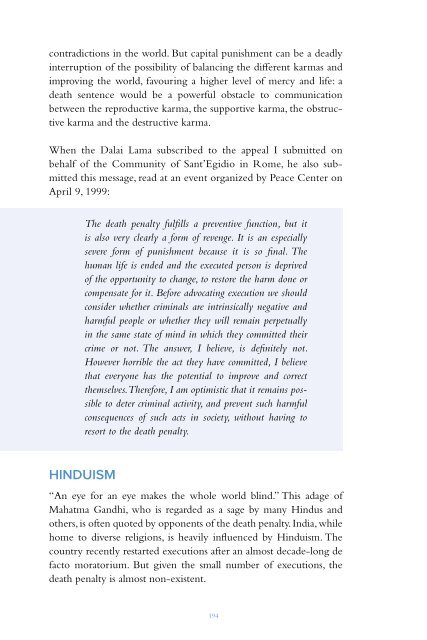PENALTY
DBk0302s7Xm
DBk0302s7Xm
Create successful ePaper yourself
Turn your PDF publications into a flip-book with our unique Google optimized e-Paper software.
contradictions in the world. But capital punishment can be a deadly<br />
interruption of the possibility of balancing the different karmas and<br />
improving the world, favouring a higher level of mercy and life: a<br />
death sentence would be a powerful obstacle to communication<br />
between the reproductive karma, the supportive karma, the obstructive<br />
karma and the destructive karma.<br />
When the Dalai Lama subscribed to the appeal I submitted on<br />
behalf of the Community of Sant’Egidio in Rome, he also submitted<br />
this message, read at an event organized by Peace Center on<br />
April 9, 1999:<br />
HINDUISM<br />
The death penalty fulfills a preventive function, but it<br />
is also very clearly a form of revenge. It is an especially<br />
severe form of punishment because it is so final. The<br />
human life is ended and the executed person is deprived<br />
of the opportunity to change, to restore the harm done or<br />
compensate for it. Before advocating execution we should<br />
consider whether criminals are intrinsically negative and<br />
harmful people or whether they will remain perpetually<br />
in the same state of mind in which they committed their<br />
crime or not. The answer, I believe, is definitely not.<br />
However horrible the act they have committed, I believe<br />
that everyone has the potential to improve and correct<br />
themselves. Therefore, I am optimistic that it remains possible<br />
to deter criminal activity, and prevent such harmful<br />
consequences of such acts in society, without having to<br />
resort to the death penalty.<br />
“An eye for an eye makes the whole world blind.” This adage of<br />
Mahatma Gandhi, who is regarded as a sage by many Hindus and<br />
others, is often quoted by opponents of the death penalty. India, while<br />
home to diverse religions, is heavily influenced by Hinduism. The<br />
country recently restarted executions after an almost decade-long de<br />
facto moratorium. But given the small number of executions, the<br />
death penalty is almost non-existent.<br />
Those who do support the death penalty give reasons that are different<br />
from those most often heard in the West. The founder of the Hare<br />
Krishna movement, Srila Prabhupada, said that the reason a murderer<br />
should be condemned to death is so that “in his next life he will not<br />
have to suffer for the great sin he has committed.” 4 Another Hindu<br />
thinker has argued that<br />
Hinduism is full of compassion and forgiveness. Leave<br />
aside human beings; we are supposed to be kind even to<br />
insects and animals. We are not supposed to kill a small<br />
insect. Therefore, taking the life of a human being is a very<br />
big issue for us. Our Hindu dharma is very clear that use<br />
of violence against anyone is not allowed. Any other type of<br />
punishment may be given, but we should not take anyone’s<br />
life. Our scriptures and Vedas do not favor capital punishment.<br />
They advocate the principle of non-violence. 5<br />
That is akin to the teachings that Mahatma Gandhi made well<br />
known, rooted in Ahimsa, a Hindu form of thinking based on<br />
non-violence: “By birth I am a Vaishanavite, and was taught Ahimsa<br />
in my childhood. . . . In its negative form, it means not injuring any<br />
living being, whether by body or mind. I may not therefore hurt the<br />
person of any wrong-doer, or bear any ill will to him and so cause<br />
mental suffering.”<br />
This attitude is very nearly inscribed in the Indian Constitution,<br />
where the death penalty is reserved for “the rarest of the rarest cases.”<br />
On the one hand, this means that the framers of the Constitution must<br />
have approved of capital punishment; on the other hand, it suggests<br />
that disagreement among them was strong enough that they sought<br />
to strictly limit its use. Babasaheb Ambedkar, a primary architect of<br />
the Indian Constitution, wanted to keep capital punishment out of<br />
it. He said that while many people who believe in nonviolence may<br />
not follow it in practice, “they certainly adhere to the principle of<br />
non-violence as a moral mandate which they ought to observe as far<br />
4 Srila Prabhupada, Bhagavad-Gita as It Is (New York, Macmillan, 1968).<br />
5 Samvidananda Saraswati, the head of Kailam Ashram, in Hinduism Today (October-December<br />
2006).<br />
194 195


